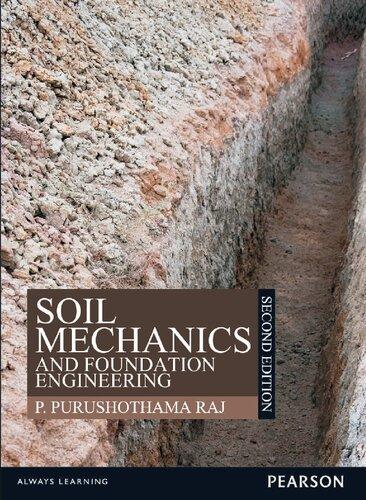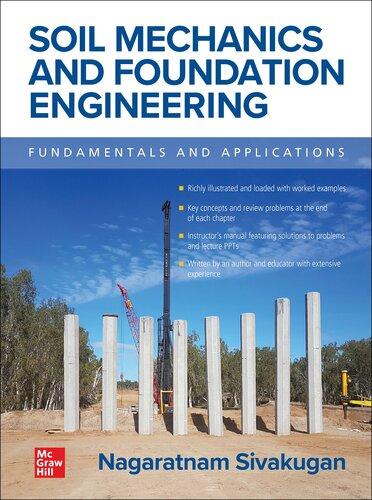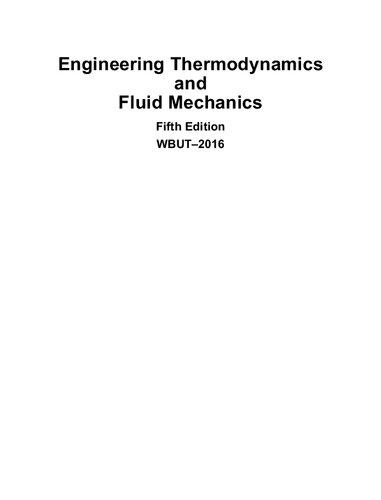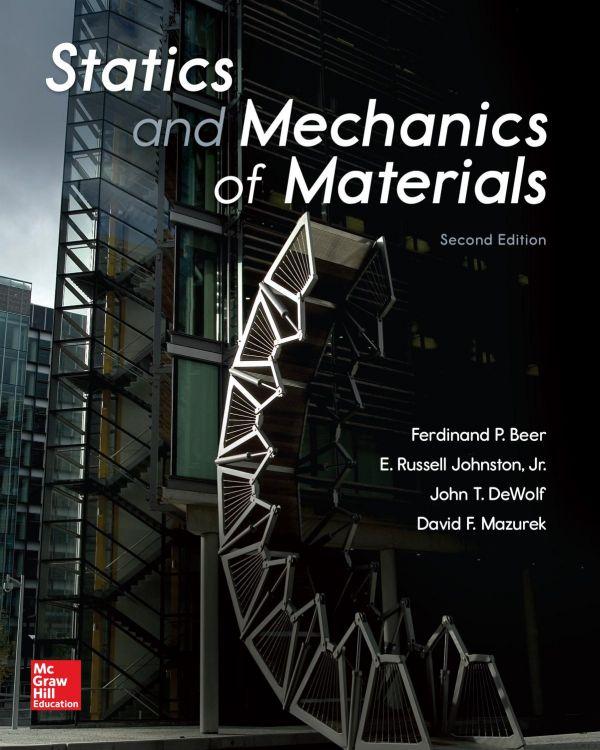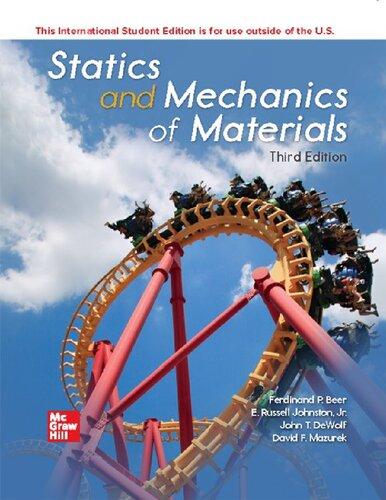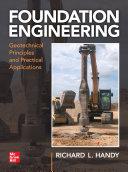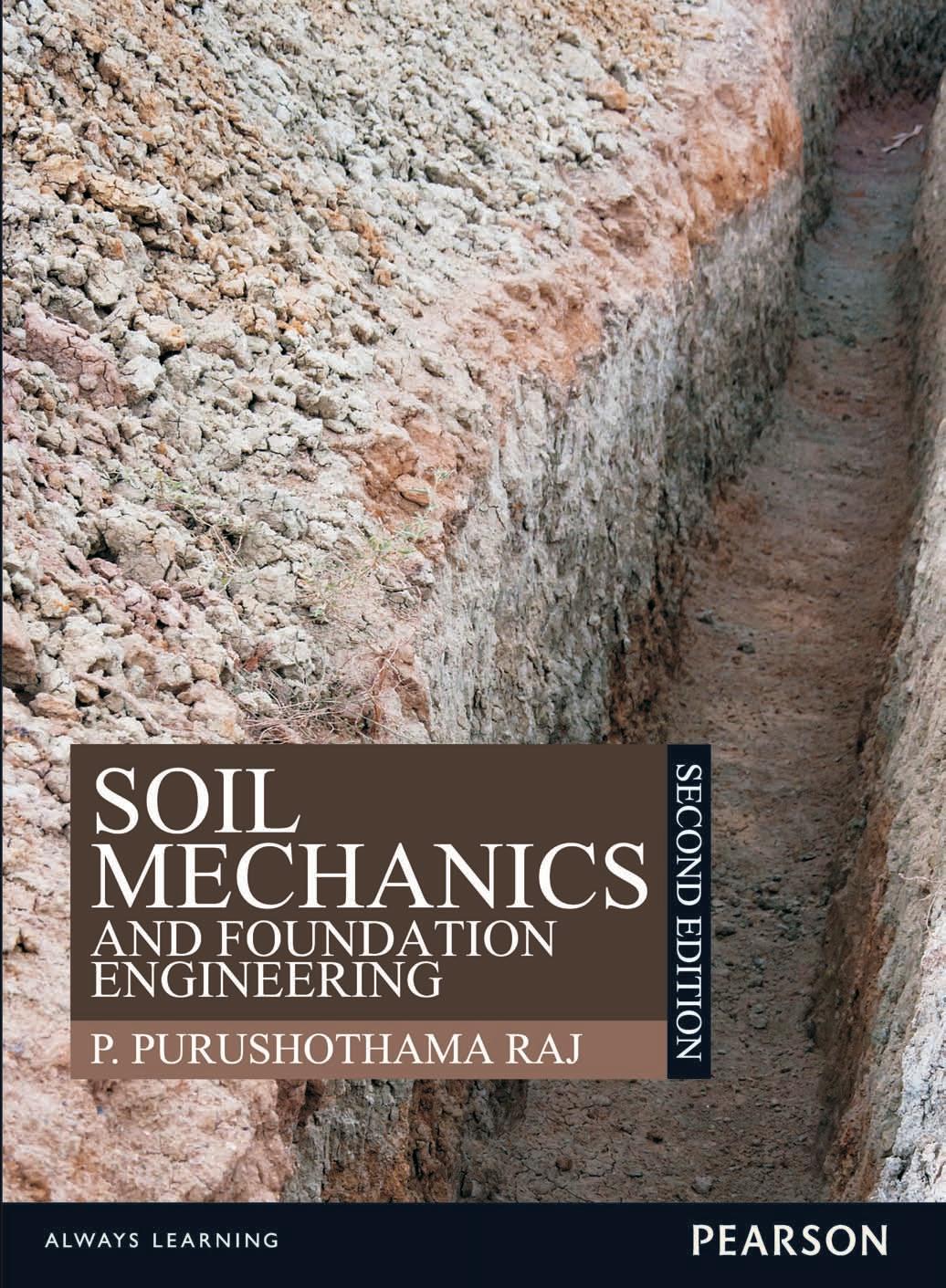Soil Formation and Composition 1
CHAPTER HIGHLIGHTS
Origin of soils – Types of rocks – Effects of weathering – Soil formation –Major soil deposits of India – Components of soils – Size and shape of soil particles – Inter-particle forces – Soil minerals – Soil–water system – Soil structure
1.1 INTRODUCTION
Soil is an unconsolidated material that has resulted from the disintegration of rocks. It includes sediments and deposits beneath rivers and seas and on land along with all organic and inorganic materials overlying the bedrock. It, thus, constitutes the earth’s surface both on land and beneath water.
The type and characteristics of soil depend largely on its origin. Transportation causes the sizes and shapes of the particles to alter and sort into sizes. Cementation due to carbonates, oxides, or organic matter provides additional particle binding. Thus, the engineering properties, viz., permeability, consolidation, and shear strength, of a soil deposit are governed by the mode of formation, stress history, groundwater condition, and physico-chemical characteristics of the parent material.
Soil deposits constitute an assemblage of solid particles resulting in the formation of certain voids or pore spaces. These voids are in turn filled with a gas or liquid or both. These components, viz., solid particle, gas, and liquid, play a significant role in the fundamental behaviour of soil. Thus, we can visualize the soil deposit as a particulate system comprising three phases, viz., the solid phase, the liquid phase, and the gaseous phase.
This chapter deals with the geological aspects of the formation of several types of soil deposits. The composition of such soil deposits has been treated as a three-phase system. The factors contributing to the behaviour of each phase and to the soil structure formation are dealt with in this chapter.
Soil
1.2 ORIGIN OF SOILS
The earth’s crust consists of both rock and weathered rock (as soil) up to an approximate depth of 20 km. Soils (weathered rocks) originated from the rocks and minerals of the earth’s crust. The principal minerals subjected to weathering to produce soil at or near the earth’s surface and available in the order of abundance are quartz, feldspar, pyroxene, amphibole, etc. Continuous slow weathering processes, aided by crustal deformities in the past, are believed to have decomposed the solid rock to fragments, creating soils. The type of soil developed depends on the rock type, its mineral constituents, and the climatic regime of the area. Rock types are grouped into three major classes: igneous, sedimentary, and metamorphic.
Cooling and hardening of molten magma resulted in the formation of igneous rocks. Slow cooling of molten magma yields large crystals, while rapid cooling results in small crystals. Granite, syenites, diorites, and gabbros have large crystals, while basalts, rhyolites, and andesites have small crystals.
Rocks containing quartz or orthoclase minerals with high silica content (e.g., granite and rhyolite) mostly decompose into sands* or gravelly** soils with a little clay.*** On the other hand, rocks (e.g., gabbros and basalt) whose minerals contain iron, magnesium, calcium, or sodium with a little silica decompose to yield fine-textured silty+ and clayey soils. Clays are not fragments of primary minerals from the parent rock but secondary minerals formed by the decomposition of primary minerals. Thus, the behaviour of clay is different from that of gravel and sand as the latter are composed of primary minerals.
Transportation agents such as wind, water, and ice may move the loose weathered rock materials and deposit them in layers called sediments. Such sediments, with the cementing properties of fragments, when subjected under heavy pressure to compaction and cementation, result in sedimentary rocks. Sedimentary type of rocks are classified as chemical (e.g., limestones and dolomites), clastic (e.g., shale and sandstone), and biochemical or organic (e.g., fossil limestone, chalk, coral, and coal in the form of peat, lignite, bitumen, or anthracite).
Sedimentary rocks, and to a lesser extent igneous rocks, when subjected to metamorphism (changes brought about by combinations of heat, pressure, and plastic flow), undergo changes in their texture, structure, and mineral composition, resulting in rocks called metamorphic rocks. Metamorphism is of two types, thermal and dynamic. Thermal metamorphism occurs primarily due to temperature increase and high hydrostatic pressure, whereas dynamic metamorphism is due to differential pressure. Metamorphism changes limestone to marble, sandstone to quartzite, and shale to slate.
Metamorphic rocks may be categorized as foliated or non-foliated. Foliation occurs during the process of metamorphism when some metamorphic rocks reduce back to sedimentary rocks. Gneiss and schist decompose into silt–sand mixtures with mica, slates and phyllites to clays, marble to limestone, and quartzite to sands and gravels.
The cyclic process of transforming rock to soil and vice versa is a continuous process occurring over millions of years through complex chemical and physical processes. This phenomenon, referred to as the geological cycle, is schematically shown in Fig. 1.1.
Particle sizes: *sand, 0.075 to 2 mm; **gravel, 2 to 4.75 mm; ***clay, < 0.002 mm; +silt, 0.002 to 0.075 mm.
Igneous rocks
Possible melting of deep rocks
Heat, pressure, and solution
Melting of deeply
buried rocks
Metamorphic rocks
Erosion and weathering
Gravel, sand, mud, and other sediments
Heat, pressure, and
solution
Weathering, deposition, and consolidation
Sedimentary rocks
1.3 TYPES OF WEATHERING
Rock disintegration, also called weathering, is one of the important geological processes. This disintegration of rock produces and deposits unconsolidated sediments as soils for plant and animal life. Weathering may be either physical (or mechanical) or chemical.
1.3.1 Physical Weathering
The process by which rock disintegrates into smaller fragments due to factors like stress changes, climatic changes, etc., without involving any change in its properties is called physical or mechanical weathering.
The principal factor causing physical weathering is climatic change. Adverse temperature changes coupled with different thermal coefficients of rock minerals produce rock fragments. The effect will be greater when temperature changes cause a freeze–thaw cycle. Similarly, heavy rainfall also brings about physical weathering.
Stress readjustments during regional uplift, accompanied by water runoff, cause the outer shell to separate from the main rock. This process is called exfoliation and may also be caused by sudden temperature changes.
On a rugged topography, heavy wind and rain may cause erosion of the rock surface and move disintegrated fragments. This is a continuing event and depends on the type of topography and the velocity of wind and water. Abrasion of rock is caused by ice under pressure or by the pushing of large unconsolidated materials. Mechanical weathering may also be caused by organic activity, such as cracking forces exerted by plants growing in the crevasses of rocks and the moving of fragments towards the surface by animals or insects.
Fig. 1.1 Geological cycle (Source: Bowles, 1984)
1.3.2 Chemical Weathering
Due to alteration in the chemical properties of rock minerals, new compounds are formed. This is referred to as chemical weathering. Rainwater coming in contact with rock surfaces reacts forming hydrated iron oxide, carbonates, and sulphates. If there is a volume increase, the disintegration continues further. Rainwater with pH < 7, or with carbonic acid, may react chemically with some rock (e.g., limestone) and completely dissolve it. Further, during a geological time period, even a weak acid solution may cause decomposition. Due to leaching, sedimentary rocks may lose their cementing properties.
1.4 SOIL FORMATION
Based on the method of formation, soil may be categorized as residual and transported. Residual soils are formed from the weathering of rocks and practically remain at the location of origin with a little or no movement of individual soil particles. Transported soils are those that have formed at one location (like residual soils) but are transported and deposited at another location.
1.4.1 Residual Soils
Weathering (due to climate effects) and leaching of water-soluble materials in the rock are the geological processes in the formation of these soils. The rate of rock decomposition is greater than the rate of erosion or transportation of weathering material and results in the accumulation of residual soils. As the leaching action decreases with depth, there is a progressively lesser degree of rock weathering from the surface downwards, resulting in reduced soil formation, until one finally encounters unaltered rock (Fig. 1.2). Residual soils generally comprise a wide range of particle sizes, shapes, and composition. In general, the rate of weathering is greater in warm, humid regions than in cold, dry regions. Humid, warm regions are favourable to chemical weathering. Also, because of the
Soil – Humus
Surficial Soil Zone (Oldest Soil Material)
Completely Weathered Rock Zone (Virtually all Soil Material)
Highly Weathered Rock Zone (Mostly Soil Material)
Moderately Weathered Rock Zone (Distintegrated Rock)
Slightly Weathered Rock Zone
Unweathered Rock with Fissures and Fractures in Upper Zone
1.2 Stages of formation of residual soil (Source: McCarthy, 1982)
Fig.
presence of vegetation, there is less possibility of transportation of the decomposed materials as sediments. Residual soils exist in different parts of the world, viz., Asia, Africa, south-eastern North America, Central America, and South America. Sowers (1963) reported that the depth of residual soils varies from 6 to 25 m in general and from 7.5 to 15 m in South India.
1.4.2 Transported Soils
Weathered materials have been moved from their original location to new locations by one or more of the transportation agencies, viz., water, glacier, wind, and gravity, and deposited to form transported soils. Such deposits are further classified depending on the mode of transportation causing the deposit.
Water-transported Soils. Swift-running water is capable of moving a considerable volume of soil. Soil may be transported in the form of suspended particles or by rolling and sliding along the bottom of the stream. The size of the particle that can be in suspension is related to the square of the velocity of the flowing water. Particles transported by water range in size from boulders to clay.
Coarser particles are dropped when a decrease in water velocity occurs as the stream or river deepens, widens, or changes direction. Fine particles still remain in suspension and get deposited in quieter waters downstream. This is a typical case of a stream moving downhill, passing over a valley, and ultimately reaching a large body of water. Soils that are carried and deposited by rivers are called alluvialdeposits. River deltas are formed in this manner. Soils carried by rivers, while entering a lake, deposit all the coarse particles because of a sudden decrease in velocity. Such coarse soil deposits are called lakedeltas. But the finegrained particles move to the centre of the lake and settle when the water becomes quiet. Alternate layers are formed with season, and such lake deposits are called lacustrinedeposits These deposits are weak and compressible and pose problems for foundations. If coarse and fine-grained deposits are formed in sea water areas, then they are called marinedeposits. Marine sediments are made up of terrestrial and marine contributions. The terrestrial contribution consists of particulate material eroded from the shore, as well as mineral matter, in true or colloidal solution, and this contribution decreases both in proportion and in grain size with increasing distance from the shoreline. The marine contribution is represented by the organic and inorganic remnants of dead marine life, and this normally increases with time (Iyer, 1975).
In marine deposits, marine life and environment play a more significant role than the salt concentration of the water. The clay particles absorb certain chemical elements from the organisms, which in turn can extract mineral substances from sea water. Some acids produced by the digestive tracts of marine organisms can alter the composition of the clay minerals (Iyer, 1975).
Marine clay deposits (excluding the deep deposits which have been subjected to many further changes and are overlain by other deposits) are generally weak, compressible, and problematic for foundations. If such a deposit is exposed above sea level and experiences leaching of sodium due to percolation of fresh water, it becomes very sensitive to disturbance. Glacial soils transported by rivers from melting glacial water create deposits of stratified glacial drift and are referred to as glaciofluvialdeposit or stratifieddrift.
Glacial Deposits. Compaction and re-crystallization of snow leads to the formation of glaciers. Glacier growth and movement depend on the formation of ice. Glacial deposits
Soil Mechanics and Foundation Engineering
form a very large group of transported soils. A glacier moves extremely slowly but deforms and scours the surface and the bedrock over which it passes. Melting of a glacier causes deposition of all the materials, and such a deposit is referred to as till. The land form or topographic surface after a glacier has receded is called a groundmoraine or tillplain. Till deposits which have been overrun by glaciers contain coarser particles and form good construction material.
Soils deposited by the surface and sub-surface glacial rivers that remain in the form of long-winding ridges are called eskers. They may vary from about 10 to 30 m in height and about 0.5 km to several kilometres in length. Isolated mounds of glacial debris varying from about 10 to 70 m in height and 200 to 800 m in length are called drumlins. Large boulders picked up by a glacier, transported to a new location, and dropped are called erratics.
Glacial deposits provide a poor to excellent foundation. In many locations it is often found that the material is dense and contains considerable sand and gravel. It is believed that glaciers covered a large portion of the land during the ice age. Northern USA, Northern Europe, and Canada were subjected to continent glaciers. Now glaciers cover approximately 10% of the earth’s surface. Almost all glaciers are now concentrated in Greenland and Antarctica.
Wind-transported Soils. Like water, wind can erode, transport, and deposit fine-grained soils. Soils carried by wind are subsequently deposited as aeoliandeposits. Dunes are formed due to the accumulation of such wind-deposited sands. Dunes are a rather common occurrence in the desert areas of Africa, Asia, and the USA. Sands from dunes may be used to a limited extent for construction purposes.
Fine-grained soils such as silts and clays can be transported by wind in arid regions. Wind-blown silts and clays deposited with some cementing minerals in a loose, stable condition are classified as loess. Loess deposits have low density, high compressibility, and poor bearing resistance when wet. Loess is a clastic sediment comprising a uniformly sorted mixture of silt, fine sand, and clay-size particles. The structure of a loess deposit is susceptible to collapse on saturation.
Gravity Deposits. Gravity can transport materials only for a short distance. As the movement is limited, there is no appreciable change in the materials moved. Gravity deposits are termed talus. They include the material at the base of cliff and landslide deposits. The talus material at the cliff is formed due to the disintegration and subsequent failure of the cliff face. These fragments are generally loose and porous.
Swamp and Marsh Deposits. In water-stagnated areas where the water table is fluctuating and vegetational growth is possible, swamp and marsh deposits develop. Soils transported and deposited under this environment are soft, high in organic content, and unpleasant in odour. Accumulation of partially or fully decomposed aquatic plants in swamps or marshes is termed muck or peat. Muck is a fully decomposed material, spongy, light in weight, highly compressible, and not suitable for construction purposes.
1.4.3 Desiccated Soils
If a fine-grained soil is exposed to atmosphere, water is drawn from the interior to the surface. From the surface, the water gets evaporated. This sort of drainage is referred to as drainage by desiccation. During this process the soil becomes stiffer and ultimately becomes hard. The point at which evaporation ceases depends on the relative humidity of the air around.
Under field conditions, desiccation may take place whenever the surface of the soil is not permanently flooded. Due to periodic desiccation, even fine-grained silty sands show apparent cohesion.* As the apparent cohesion is very large, even rains of long duration cannot completely remove the cohesion. This phenomenon of desiccation is very much pronounced in soils of semi-arid and arid regions. Such soils are quite often mistaken for soft rocks. In the case of soft clays, the desiccation proceeds very slowly from the exposed surface and forms a thick crust, and the thickness grows with age.
1.5 MAJOR SOIL DEPOSITS OF INDIA
Among different types of soils spread over the Indian Peninsula, only five major deposits have been identified (Katti et al., 1975), viz., marine deposits, black cotton soils, laterite and lateritic soils, alluvial deposits, and desert soils. Figure 1.3 shows the regions covered by these soil deposits.
1.5.1 Marine Deposits
The marine deposits all along the Indian coast are generally derived from terrestrial sources. These deposits cover a narrow belt of tidal flats all along the coast from Porbandar in the west to Puri in the east. However, they are present over wide areas in places such as Rann of Kutch. These tidal flats experience high tide inundation. The deposits are very soft to soft clays, and the thickness varies from 5 to 20 m. The clay is medium sensitive and inorganic in nature. These deposits generally need a pre-treatment before application of any external load (Iyer, 1975). In order to prevent failures during construction, controlled loading should be planned (Katti et al., 1975).
1.5.2 Black Cotton Soils
Black cotton soil is one of the major soil deposits of India and is spread over a wide area of 3,00,000 km2. The primary bed rock is basalt or trap, and in some locations, quartzites, schists, and sedimentary rocks are also reported (Katti et al., 1975). The black cotton soil is expansive in nature due to the presence of montmorillonite and illite clay minerals. The top black subsoil varies in thickness up to a maximum of 20 m. Based on the pedological conditions, crack depth and pattern vary. The soil surface is hard during summer and becomes slushy during the rainy season. The effect of seasonal moisture change brings in volume changes up to a maximum depth of 1.5 m. Because of the swelling and shrinking nature of the soil, there is a necessity for treatment of the soil, and special foundations need to be adopted in such soils to prevent failure of structures.
1.5.3 Laterites and Lateritic Soils
In tropical regions of high moisture and temperature, weathering activity is so intense that a tremendously thick soil (exceeding 30 m) may be formed from the parent rock through processes collectively termed laterization. Laterization is mainly due to the decomposition of
*A temporary shear strength gained by weathering.
Marine
Black cotton
Laterites and lateritic soils
Alluvial deposits
Desert soils
Fig. 1.3 Map of India showing approximate extent of major regional deposits (Source: Katti et al., 1975)
rock, removal of silica and bases, and accumulation of aluminium and iron sesquioxides. The red, pink, or brown colour of laterites is essentially due to the presence of iron oxide. If about 90% of the material contains coarse grains, then this is called laterite; instead, if relatively fine grains are present, it is referred to as lateriticsoil. In India, lateritic soils spread over an area of 100,000 km2. Indian laterites are mostly residual soils.
The characteristic property of this type of soil is high strength when it is cut and dried in the sun. The specific reason for such a behaviour has been attributed to the dehydration of iron oxides and the presence of halloysite type of clay mineral. Some of the laterites show extremely high strength comparable to that of burnt bricks. After hardening, the strength gained is not affected when it comes in contact with water. Rao and Raymahashay (1981) studied the mineralogy of Calicut and Rajahmundry laterites. Calicut laterites were found to be rich in halloysite and crystalline goethite, whereas Rajahmundry laterites showed the presence of crystalline kaolinite and metahalloysite. The reason for the difference has been attributed to the geological environment of the areas.
The formation of sesquioxides in the top layers during laterization and weathering of the bottom layers present serious problems for civil engineers in the assessment of lateral stresses in lateritic profiles (Iyer and Pillai, 1972). Further road cuts in such deposits pose a serious stability problem.
1.5.4 Alluvial Deposits
The well-known alluvial deposits of India are in the Indo-Gangetic and Brahmaputra flood plains. Alluvial deposits exist up to a depth of 100 m. The north of the Vindhya Satpura range is covered with river alluvium, and other alluvial deposits of deltaic type are also present. Alluvial deposits exhibit alternate layers of sandy silt and clay, and in some locations organic layers are also encountered. The Bengal basin is another important alluvial deposit. The subsoil of the upper strata (which is of immediate relevance to civil engineers) is of recent origin and is believed to have been deposited by the Ganga river system. The soil around the Calcutta (now Kolkata) region, usually referred to as the Calcutta deposit, consists primarily of desiccated brownish grey silty clay up to a depth of about 15 m. Another deposit of the Bengal basin is the river channel deposits, consisting of sandy silts to silty sands up to a depth of 30 m (Som, 1975).
Alluvial sands are used as fine aggregates in concrete, whereas alluvial clay is used for manufacturing of bricks.
1.5.5 Desert Soils
The Thar Desert covers most of the area of the continent which forms the desert soil of India. These are wind-blown deposits generally present in the form of sand dunes. These deposits are formed under arid conditions and are predominantly of fine or silty sands. Scarcity of water is a serious problem for any construction activity.
1.6 COMPONENTS OF SOILS
The composition of natural soils may include diverse components which may be classified into three groups (Fig. 1.4): (i) solid phase (minerals, cementation, and organic material), (ii) liquid phase (water with dissolved salts), and (iii) gaseous phase (air or some other gas with water vapour). These are the components of a soil which affect its engineering properties.
1.6.1 Solid Phase
This consists of primary rock minerals, clay minerals, and cementing and organic materials. One or all may be present in a soil.
phase
Gaseous phase of soil elements
(a) Elements of natural soil(b) Representation
Primary Rock Minerals. These are rock fragments from the parent rock, formed due to weathering. In general, they are relatively large in size and rounded or angular in shape. When such particles form a major part of the soil minerals (as in gravels and sands), the engineering properties will be governed by the gradation and packing of the grains. The shape and texture of such particles (discussed in the next section) may have some bearing on the properties.
Clay Minerals. These are secondary minerals formed by chemical weathering, and the particle size is less than 2 μm. The particles commonly occur in the form of flat plates and are flaky in shape. The main characteristic of such particles is their large surface areas. A detailed treatment of clay minerals is presented in the next section.
Cementing and Organic Materials. Due to the decomposition of minerals by leaching or due to the presence of dissolved salts, certain cementing materials (such as calcite, iron oxide, or silica) may be deposited on the surface of the soil particles. Such materials improve the engineering properties of soils.
Organic matter in the soil has originated from plant or animal remains. It generally occurs in the top soil up to a depth of 0.5 m. Muck or peat deposits are primarily organic in nature and occur at considerable depths. Organic matter absorbs more water, compresses considerably under a load, fails due to low bearing resistance, and affects the setting of foundation concrete. Thus, organic materials have many undesirable properties harmful for engineering structures.
1.6.2 Liquid Phase
In soils of interest to the civil engineers, the only liquid phase is water. In geotechnical engineering, water is the prime factor which governs the engineering properties of soils. It is an incompressible fluid capable of taking normal stresses but not shear stresses.
Water can dissolve and transport, in solutions, various salts and compounds, some of which may seriously affect the soil behaviour. Calcium sulphate occurs in many clays but is only slightly soluble. Sulphate ion solutions in water have adverse effects on the properties of concrete structures.
Fig. 1.4 Components of natural soil
1.6.3 Gaseous Phase
Air is the gaseous phase found in soil. It is extremely difficult to get a perfectly dry soil or fully saturated soil. The so-called saturated soils contain about 2% of air voids. Similarly, in dry soil, water vapour may exist. In partially saturated soils, because of vapour pressure and a continuous air path, there may be migration of water in the form of water vapour.
1.7 PARTICLE SIZES AND SHAPES
Naturally occurring soil deposits comprise soil particles of varying sizes and shapes. Size and, to a lesser extent, shape are factors that affect the material behaviour of a soil. However, most engineering properties are not controlled by particle size and shape but depend on soil mineral composition, interaction with water, and soil structure.
1.7.1 Particle Size
A soil particle does not have a specific size and shape so that a unique linear dimension can be assigned (as in a solid of regular geometrical shape). Thus, a representative size for the particle has to be fixed, based on a certain analysis (as defined in sieve or hydrometer analysis, discussed in the next chapter).
Soil may have particle sizes as big as several centimetres (pebbles) or as small as 10–6 mm (colloid). It is reasonable to assign a name to a certain size range. Such names and their size ranges are given below.
Cobbles or pebbles – rock fragments, size range 150 to 300 mm
Gravel – rock particles, size range 4.75 to 150 mm
Sand – rock particles, size range 0.075 to 4.75 mm
Silt – rock particles, size range 0.002 to 0.075 mm
Clay – mineral particles, size <0.002 mm (i.e., <2 μm)
The lowest particle size which could be identified without magnification is sand, and hence particle sizes (sand and above) bigger than 0.075 mm are grouped under coarse-grained soil. Particle sizes less than 0.075 mm are grouped under fine-grainedsoil because they are too small to be seen without magnification.
1.7.2 Particle Shape
The shape of individual particles depends on the parent rocks, their age, degree of weathering, and transporting processes. In general, all soil particles except clay-size particles which are plate-like in shape are approximately equidimensional. Other shapes common to clay-size particles are rods and laths.
Generally, the edges of a new coarse-grained particle are angular and rough surfaced, but with time they become round and smooth. The sharpness of the edges and corners of a particle is referred to as the degree of roundness. The degree of roundness in increasing order may be given as angular, sub-angular, sub-rounded, rounded, and well rounded. Figure 1.5 shows five levels of degree of roundness.
